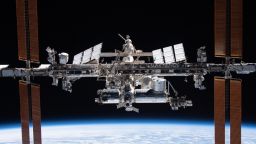Since the earliest days of the International Space Station, NASA has been exploring ways to get the private sector more involved, with the hope of bringing a capitalistic bent to a program that eats up a couple billion dollars worth of taxpayer money each year.
But now the ISS is aging, cracks are appearing in its facade, spaceborne debris is hammering the exterior, and tensions between the United States and its primary ISS partner, Russia, are at all time highs. All of that makes mapping out the future of low-Earth orbit in a post-ISS world more pressing than ever.
The most recent roadmap for decommissioning the ISS was published this week, and it lays out a plan to bring the space station out of orbit in January 2031, plunging it into a watery grave in a remote area of the Pacific Ocean. It will mark the end of an era for a hallmark program that put scientific research and international collaboration at its center.
And the space station has also been an early incubator for companies testing the waters for potential business activity in space, serving as the platform for contracts given to a young SpaceX — at a time when the company was nearly bankrupt — and dozens of other startups and corporations. Several privately owned spacecraft are either flying or under development to service the space station. And SpaceX now owns the only commercial spacecraft in the world currently capable of ferrying astronauts back and forth from the ISS.
Those projects were all part of NASA’s broader push to foster private investment in spaceflight, hoping that one day the private sector could take over all the activity in low-Earth orbit, or LEO, which is the sphere of outer space directly surrounding our home planet that is currently home to the ISS and the vast majority of our satellites.
But we don’t know just how much of their own money businesses are willing to invest in such endeavors. Costs of spaceflight are coming down, but space travel is still expensive and relatively dangerous. Industry experts broadly agree that, regardless of how much fruit these commercialization efforts ultimately bear, NASA and the US government must still keep a presence in low-Earth orbit for science and research reasons as well as political reasons. It is possible that, regardless of which logos brand the exterior of future space stations in LEO, taxpayer dollars will still be necessary to keep them afloat.
But commercial companies are making big promises, saying they’re eager to lead the way into this new era, which could include orbiting hotels, movie studios, laboratories and manufacturing facilities.
Here’s what the end of the ISS could mean for spacefaring businesses, and what this proposed future could look like.
Commercial space stations
The ISS does already have one module — attached to the center spine of the ISS -— owned by a private company. The BEAM module, which primarily served as a test to see how well the inflatable structure would hold up in space, was installed in 2016 by Bigelow Aerospace. It was hailed as a monument to commercial potential in outer space. But Bigelow went bankrupt in 2020, and ownership of the module was transferred to NASA this year, perhaps turning BEAM into a reminder of how difficult it is to mix space travel with profit.

Overall the commercial space industry is, however, on a tear. Funding is pouring into the sector at record rates. And several companies have proposed their ideas for bringing new space stations to life. And NASA has already given seed funding to several.
First up is a project by Jeff Bezos’ Blue Origin, dubbed Orbital Reef — on which it will work alongside Boeing and an up-and-coming venture called Sierra Nevada — to put together a space station almost as large as the ISS that could be used to host science experiments, vacation getaways, and potentially even in-space manufacturing.

A separate project proposed by Houston-based company Nanoracks, which already has significant infrastructure on the ISS, suggests putting together a research base called StarLab that would be about a third of the size of the ISS and could host up to four astronauts. It could include “a biology lab, plant habitation lab, physical science and materials research lab, and an open workbench area,” according to the company, which plans to work with Lockheed Martin and a firm called Voyager Space on the project.
Then there’s a sprawling space station, proposed by Northrop Grumman, that could host four to eight astronauts and could include an attached robotic arm to keep the exterior of the spacecraft in great shape without forcing astronauts to conduct long, arduous spacewalks.
A Houston-based company called Axiom Space — the same company that is chartering flights to the ISS for paying customers this year — also intends to make its own ISS module before eventually deploying a free-flying space station. It could host a research lab and even luxuries such as a movie studio. (Tom Cruise is still apparently planning to go to space, remember?)
All of those projects have some NASA funding, and several others have been proposed by the likes of SpaceX, several space startups and even an entertainment company. But success is far from guaranteed even for those with NASA backing. Building a space station can be dangerous, time consuming and incredibly expensive.
But it’s not clear if NASA would let all of those projects fall through, either. That would leave the United States without a human presence in low-Earth orbit after the ISS is laid to rest.
The level of help NASA can lend, however, also depends on Congress. For the past couple of years, NASA has requested $150 million in funding for its efforts to commercialize low-Earth orbit and received less than $20 million.
Transportation
Taking astronauts and cargo to the International Space Station has been a major source of business for SpaceX and several other companies, including Northrop Grumman, Boeing, and a Colorado-based company called Sierra Nevada Corporation. (The latter two are still in the development phase of their spacecraft.)
But when the ISS no longer exists, those lines of business don’t necessarily just disappear.
Their spacecraft could all be used to service new, privately developed space stations if these future orbiting residences use universal adapters, allowing virtually any of these vehicles to latch on. Universal adapters are already used on the ISS, a key benefit from NASA deeply coordinating its commercial partnerships while the ISS is still in use.
It should be noted that SpaceX has also already proven that it can find customers for its Crew Dragon spacecraft without involving the ISS at all. In September 2021, it flew a crew of four space tourists on a three-day high-flying joy ride to orbit.
Research and entertainment
The ISS has been home to some crucial research for NASA, helping the agency understand more about microgravity and how spaceflight affects the human body over long periods of time. Thousands of research experiments have also taken place within its walls.
Doing away with the ISS and handing things over to the private sector has raised concerns that low-Earth orbit will become a playground for the wealthy, with its orbital hotels and movie studios.
But if commercial space stations do get up and running, the potential for in-space research can remain as long as Congress is willing to fund it, according to industry experts.
NASA could buy space aboard a commercial lab and keep publicly funded research going, a suggestion included in the official ISS transition plan published this week. Some of the groundwork for such a possibility has already been laid.

The Center for the Advancement of Science in Space, or CASIS, is an organization that oversees the ISS National Lab, which works to bring commercial and academic research to the ISS from all sorts of companies and institutions. And it’s done that — CASIS has organized research projects on board the ISS for companies such as Target, Goodyear Tires, and Big Pharma companies such as Merck and Eli Lilly, as well as public organizations like the National Institutes of Health, according to Patrick O’Neill, CASIS’ marketing and communications manager.
“We’ve had over 3000 experiments that have been happening on station, and there’s now over 30 commercial facilities that are operational,” O’Neill said, referring to projects like bringing a 3D printer to the space station for a company called RedWire.
The overarching goal is to raise awareness around the potential for research in outer space and cultivate demand, and CASIS could continue doing that even after the ISS is disbanded.
“Instead of having an ISS National Lab [on the ISS], perhaps you might segue into a low-Earth orbit national laboratory or national laboratory that encompasses some of these other commercial destinations,” O’Neill said.
To sum it up, decommissioning the International Space Station will definitely bring a moment of upheaval for NASA and its commercial partners. But if — and that’s a big if — their vision of converting low-Earth orbit into a business hub is successful, the opportunities for research will remain.
CNN’s Katie Hunt contributed






